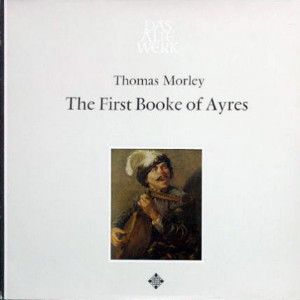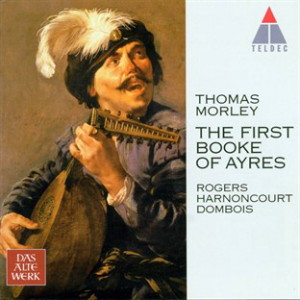 |
1 LP -
SAWT 9568-B - (p) 1970
|
 |
| 1 CD -
3984-21334-2 - (c) 1998 |
|
| Thomas Morley
(1557/58-1602) |
|
|
|
|
|
|
|
| The
First Booke of Ayres, London 1600 |
|
|
|
| - I. A Painted Tale |
|
2' 34" |
A1 |
- II.-III. Thyrsis and Milla -
She straight her light
|
|
2' 44" |
A2 |
- IV. With my love
|
|
2' 21" |
A3 |
| - V. I saw my Lady weeping |
|
3' 16" |
A4 |
| - VI. It was a Lover and his
lasse |
|
3' 40" |
A5 |
| - VII. Who is it that this dark
night |
|
4' 46" |
A6 |
| - VIII. Mistress mine |
|
2' 02" |
A7 |
| - IX. Can I forget |
|
3' 11" |
A8 |
| - X. Love winged with my hopes |
|
2' 50"
|
B1 |
| - XI. What if my mistress now |
|
1' 53" |
B2 |
| - XII. Come, sorrow, come |
|
5' 37" |
B3 |
| - XIII. Fair in a morn |
|
3' 21" |
B4 |
| - XIV. Absence here thou |
|
3' 19"
|
B5 |
- XVII. Will you buy a fine dog
|
|
1' 14" |
B6 |
| - XVIII. Sleep, slumb' ring eyes |
|
4' 49" |
B7 |
|
|
|
|
| Nigel
Rogers, Tenor |
|
| Eugen M. Dombois,
Laute (Sandro
Zanetti, Pontresina 1969) |
|
| Nikolaus
Harnoncourt, Gambe (Jacob Precheisn,
Vienna 1670) |
|
|
Luogo
e data di registrazione
|
| Vienna (Austria)
- marzo 1970 |
|
Registrazione
live / studio
|
| studio |
Producer
/ Engineer
|
Wolf
Erichson
|
Prima Edizione CD
|
Teldec
"Das Alte Werk" - 3984-21334-2 - (1 cd)
- 58' 24" - (c) 1998 - ADD
|
Prima
Edizione LP
|
Telefunken "Das
Alte Werk" - SAWT 9568-B
- (1 lp) - 48'
50"
- (p) 1970
|
|
|
Notes
|
Between
1590 and 1610 Elizabethan
Enland witnessed a great
flowering of secular music
The solo song with lute
accompaniment now took its
place alongside music for
keyboard instruments and
choral works as a distinctive
genre in its own
right. As in the case of the
madrigal, the solo song had
appeared in
numerous English printed
editions towards the end of
the 16th century seemingly
without any obvious
antecedents. It quickly
became very popular and was
cultivated assiduously until
the turn of the century.
Shakespeare's contemporaries
referred to such
songs as ďayres". However,
this word was not only used
to signify the solo song,
but in more general terms to
describe a simple piece of
music devoid of contrapuntal
elaboration. As in the case
of contemporary music for
instrumental ensembles or
keyboard instruments, the
solo song was not designed
to be performed in front of
an audience. Rather, it was
a vehicle tor personal
expression and thus
enabled musicians to
communicate with one another.
Thomas Morley was the
founding father of the
English madrigal. ln
addition to his popular
works in this genre, he
published two volumes of
solo song, This CD is
devoted to the second
volume, which was
entitled The
First Booke of Ayres or
Little Short Songs. It
was printed in
London in 1600. The texts of
the songs were written by
contemporary English poets,
and most of them are variations
on the theme of love. They
range from the simple and
descriptive pastoral idyll
to sophisticated and pensive
accounts of
a particular event. Some
make use of standard poetic
devices, whereas others are
imaginative representations
of personal feelings. Thus
playful innocence rubs
shoulders with profound
emotion Describing the joy
and the pain of love, an in
With my love my life was
nestled, or doubn
about a lover's constancy;
as in What if my
mistress now, came
just as easily to this kind
of poetry as
the images of nature which,
in Fair in a morn,
delineate the state of a lover's
soul. As in the madrigal,
texts sometimes revolve
around a single striking
idea. However, on occasion
Morley also set poetry of a
different kind. Whereas the
solemn moral of Come,
sorrow, come is the
reiection of worldly vanity,
a humorous song such as Will
you buy a fine dog contains
puns which are not easy to
understand. Even if the
poets concerned were not on
the same literary level as Petrarch,
Tasso and Guarini, their
texts were eminently
suitable when tt came to setting
them to music.
As was
usual in the case
of Morley and his
contemporaries, the music is
largely independent of the
text, and does not adhere
slavishly to the metre and
the mood. In fact, the
connection between the
poetry and the music is
rather tenuous. and the
melodic lines seldom make
rise of word painting. In
any case, since most of the
songs were strophic, this in
itself ruled out a close
relationship between the
text and the music, for, as
one strophe followed the
next, different words and
ideas were applied to the
original melody and
accompaniment. On the whole
the melodies are easy to
sing and not unduly
complicated. Moreover,
certain rhythmic
features and the frequent
alternation of duple and
triple metre help to enliven
the presentation of the
text. As a result important
words are often emphasized
in a novel manner, thereby
making a significant
contribution to a style of
declamation which is wholly
natural and true to
life. This in turn is
underpinned by the harmony
which, in certain songs such
as Come, sorrow, come,
attains to an expression
of genuine melancholy.
The lute accompaniment,
which, as
envisaged by the composer,
is strengthened by a
viola da gamha, plays an
important role in the
execution of these songs. It
not only supplies the
harmonic foundation for the
vocal line, but
often doubles the latter. In
several of the songs the
lute introduction
foreshadows the singers
opening melodic phrase. In
terms of both structure and
texture the accompaniment is
treated in a variety of
ways. It ranges from chordal
writing to the use of
independent contrapuntal
lines, and this makes a
crucial contribution to the
songs' unique exprcssirity.
Lothar
Hoffmann-Erbrecht
(1970)
Translation:
Alfred Clayton
|
|
Nikolaus
Harnoncourt (1929-2016)
|

|

|
|